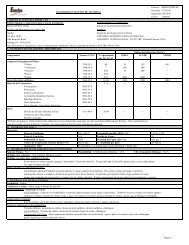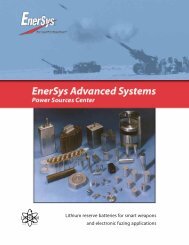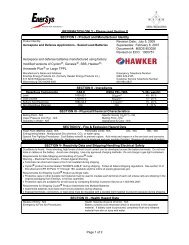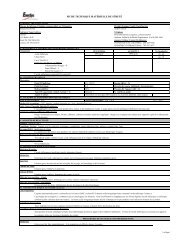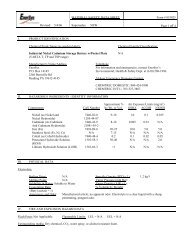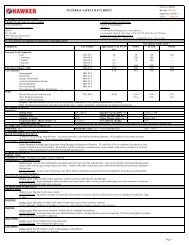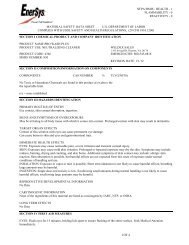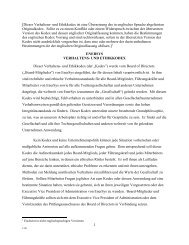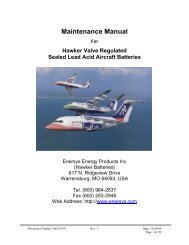enersys inc hawker - Cantec Systems
enersys inc hawker - Cantec Systems
enersys inc hawker - Cantec Systems
You also want an ePaper? Increase the reach of your titles
YUMPU automatically turns print PDFs into web optimized ePapers that Google loves.
%<br />
State<br />
of<br />
Charge<br />
C 20<br />
100<br />
90<br />
80<br />
70<br />
60<br />
50<br />
40<br />
30<br />
20<br />
10<br />
State-of-Charge vs OCV<br />
Figure 4<br />
Doc Ref : 2602-0052 Rev 00<br />
0<br />
11.3 11.4 11.5 11.6 11.7 11.8 11.9 12.0 12.1 12.2 12.3 12.4 12.5 12.6 12.7 12.8 12.9 13.0<br />
If the OCV is less than 10V but above 4V, carry out Deep Discharge Recovery in accordance with<br />
para 1-6. Otherwise, charge in accordance with para 1-5.<br />
5. Perform a Capacity Test in accordance with para 1-7. Charge the battery in accordance with<br />
para 1-5. If the discharge duration is equal to or in excess of 240 minutes, prepare the battery<br />
for issue.<br />
6. Otherwise, repeat step 5, twice if necessary, to achieve 240 Minutes discharge duration.<br />
7. If the battery still fails to achieve 240 Minutes minimum, reject the battery.<br />
1-9 FAILED BATTERIES<br />
Rested OCV<br />
1. The battery is a non-repairable unit, and is covered by a limited warranty. To determine<br />
warranty status, read the date of commissioning marked on the battery. If less than one year<br />
has elapsed, the battery is still under warranty.<br />
2. Failed batteries that are under warranty should be fully charged if possible, and notification,<br />
together with service history and fault particulars, sent to the manufacturer.<br />
3. Failed batteries that are not under warranty should be disposed of in accordance with Federal,<br />
State & Local regulations. The battery contains some hazardous materials.<br />
SECTION 2<br />
1-4




